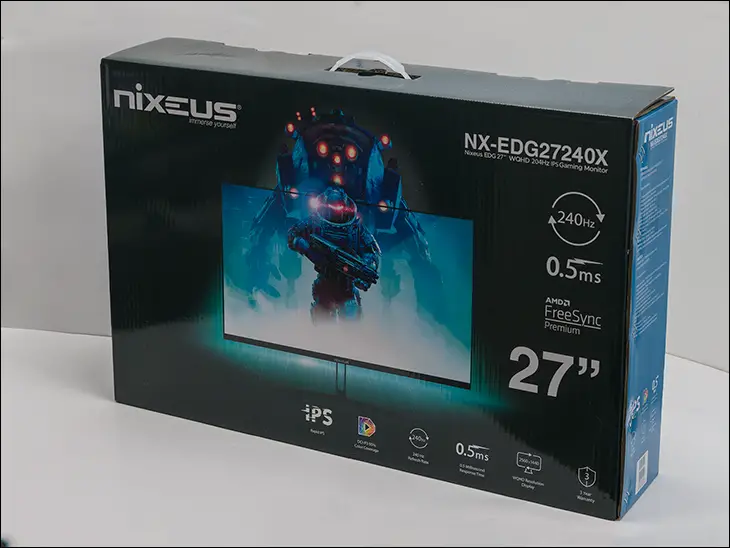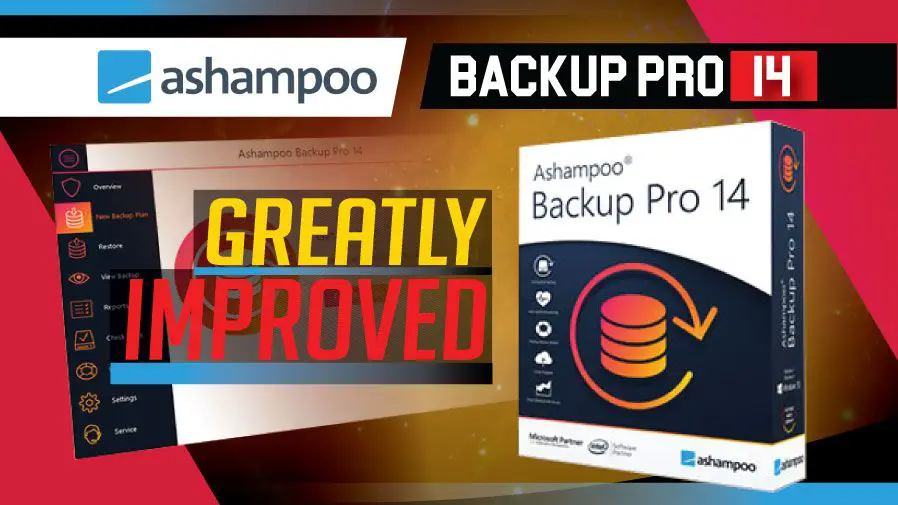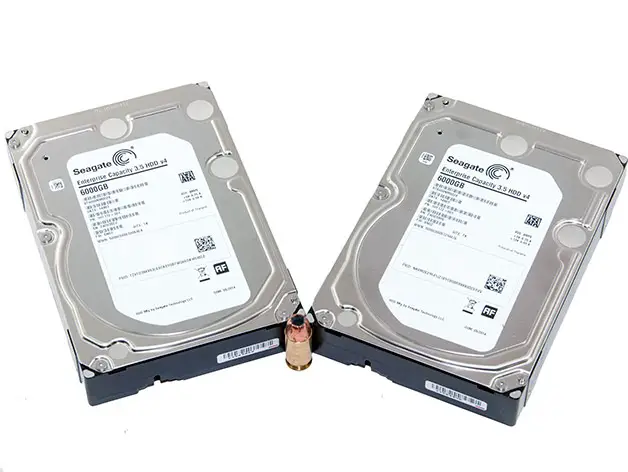
In a rather interesting turn of events, it appears that Nixeus has finally opted for a more mature shipping container design. Make no mistake the older Engineered and Designed for Gamers boxes were rather good. Black with color accents ‘just works’. Some however did find those boxes a bit too aggressive looking for their conservative values as it did spend too much effort trying to attract your inner child. The new cardboard box on the other hand may still be just as striking and attention getting as its predecessors, but it has a much more mature theme. Mix in the usual levels of information that Nixeus are known for including, and overall this is a shipping container that works very well at first attracting and then persuading buyers interested in spending this amount of money on a 1440P monitor.

The internal protection configuration is also top notch, if not changed one whit from previous models. We have zero issues with this as generous amount of form-fitting Styrofoam fully encase the monitor and even partially cover the accessories. Put another way this is classic Nixeus, and we are glad to see they did not change things in this critical area.

Much like the exterior, Nixeus has stepped up their game when it comes to the accessories they include on their premium models. Make no mistake this is still a monitor from a value-oriented company so you if you are looking for goo-gaws, or doorknob hangers, or MSRP increasing dross… this is not the monitor for you. Instead, what Nixeus has done is step up the quality of the components included. Yes, the grand total of the included accessories still is only one DisplayPort cable (though it is now DP1.4 compliant and not just 1.2), an easy-to-understand installation pamphlet, and an external power supply. Yes, Nixeus really should include a HDMI cable. No. This is not the same as what previous monitors came with.
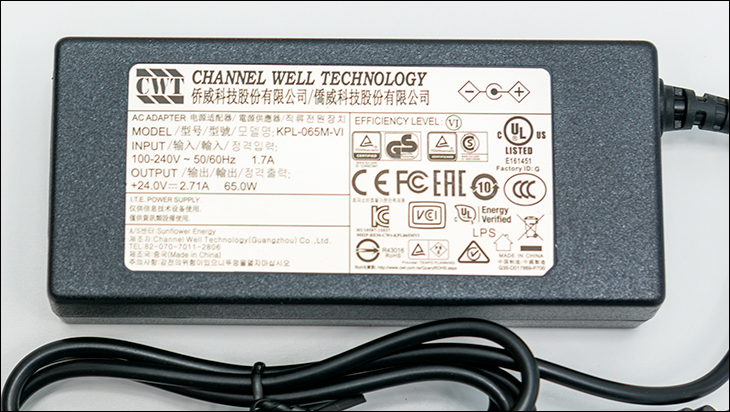
While the noticeably better DP cable is nice, the key difference is in the power brick included. Past models came with decent power adapters from various manufactures. All were ‘good enough’. The EDG-27240X on the other hand comes with a, 65-watt, Channel Well Technology power supply. CWT make excellent external power supplies and seeing one included neatly removes one of the minor worries we had over the EDG27240X compared to more expensive models… that typically also use CWT adapters. Now that is how you make a good first impression to knowledgeable, and mostly jaded, experienced buyers. So, while still room for improvement this is a very nice and noticeable improvement nonetheless.
Moving on.

While not overly important to us, the overall aesthetics of the EDG27240X are much more conservative than the EDG27X. We have zero issues with this as we rarely look at the back of our monitor and front on both are extremely similar – with the EDG27240X winning in some areas and the EDG27X being more optimal in others. Mostly though, the two are classic Nixeus and tied in the aesthetics department.
For example, the front of both monitors makes use of AU Optronics latest 3-edge ‘edgeless’ configuration in that the actual borders of the panel are hidden behind (nearly) edge to edge screen protector. This does give a modern look and vibe to both and quite honestly makes both easier to clean… as there are fewer edges for dust/lint/etc. to get trapped by over time.
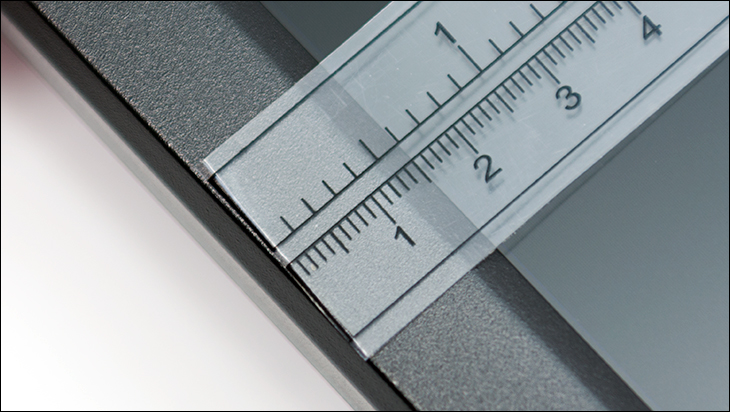
When powered on, both (basically) have the same actual border widths. The left, right and top are about 8.5 to 9 millimeters thick, and the bottom is about 15-16mm. For single monitor configurations these svelte dimensions will not matter all that much beyond making for a rather pretty monitor, but for dual/tri/quad monitor configurations these narrower gaps do make a difference and make for a more ‘seamless’ visual experience.

As made mention previously, with its all-black body and white lettering the EDG27240X is the more conservative and/or practical looking of the two. Thus, if ‘personality’ is important the red accents of the EDG27X will be more to your liking and allow your seating area to standout in even in a busy LAN gaming tournament. Most however will consider these artistic styling differences moot… as their monitor will be on a desk with the back towards a wall.
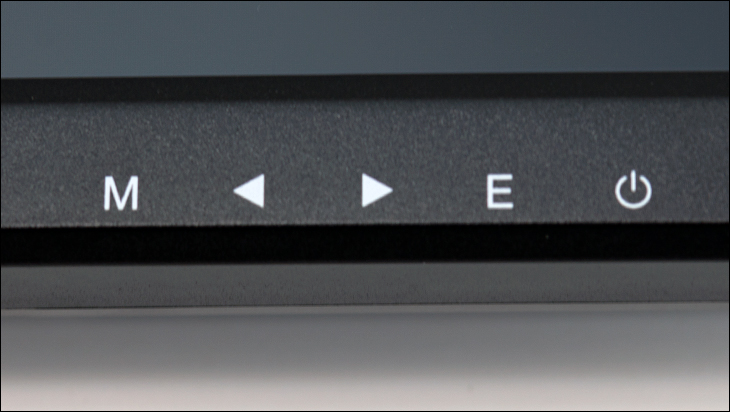
What will however matter, to most, is the amount of white lettering that Nixeus has used on their EDG27240X. With the EDG27X, the only splashes of (white) coloring on the front is in the form of the Nixeus logo. The rest of the front is much like a blank keys mechanical keyboard in that nothing is visible. This certainly gives the EDG27X a more aggressive ‘stealth’ like appearance, but when it comes time to use the physical buttons included you need to know layout by heart. The EDG27240X on the other hand has them clearly marked. Small tweak, major impact.

Furthermore, Nixeus not only listened but already implemented the negative(ish) feedback over the placement of said OSD buttons. Gone is halfway up the side layout and instead they have placed them where they belong – along the bottom right side of the back of the monitor. Better still, Nixeus did not throw the baby out with the bathwater. So, while the location of said physical buttons has changed the physical, tactile switches underneath the ‘buttons’ has not. This combination of easy to read and easy to use buttons makes the EDG27240X the clear winner in aesthetics… as form should always follow function.
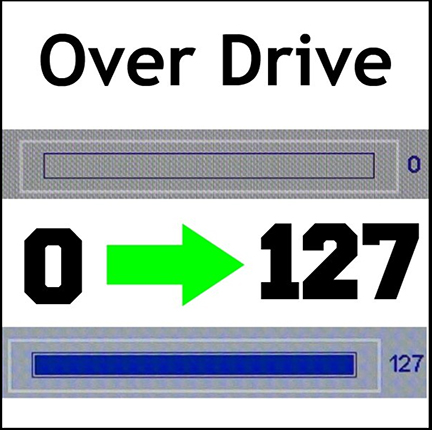
Thankfully, or unfortunately depending on your point of view, the OSD itself has not changed and is best described as “classic Nixeus”. That is to say, good bordering on greatness… but nowhere close to offering the abilities that the EDG274K has to offer. Basically, you get multiple physical buttons that are nicely sized, and very tactile for navigating / controlling the OSD… you just will not get 6 axis color correction or other highly advanced features. For professionals, this may or may not matter (as most should already own a colorimeter and not be messing with OSD level tweaking). For home user’s the standard R/G/B options are ‘good enough’… as R/G/B is a lot easier to get things dialed in ‘good enough’ without the hassle factor that 6-axis color correction is notorious for. One thing is for certain, and has been improved over the EDG27X, the amount of customization you can do to overdrive settings. With the EDG27X you had 1 to 100 (or each change resulted in 1 percent change in OD). The EDG27240X on the other hand takes a page directly from the EDG274K and comes with 127 acceleration levels. Now that is nice to see – as more precision is always welcome.
The above are all things that vary in importance. However, the success of a monitor lives or dies on a few key areas. Key areas are ones that should be important to most potential buyers. In no particular order they are: panel (and its hardware), I/O connectivity, input features, and the included stand. Of these key areas Nixeus did not just get most of them right they knocked them right out of the park.

We have already gone over the input hardware and how impressed we are with the seemingly small but big impact, tweaks, Nixeus has done since they designed the EDG27X. So, the next is the next logical choice is IO connectivity. As with the OSD button location Nixeus listened to feedback and improved upon the EDG27X’s I/O port options. As such, one can expect to find dual HDMI, dual DisplayPort headers, a 3.5mm audio jack, and surprisingly decent speakers (though the improvements are from the location of said speakers) . Furthermore, while the HDMI standard they support is the same as the EDG27X (HDMI 2.0) the DisplayPort standard has been upped from 1.2a to 1.4. This means that not only is this an extra DP header included, but the bandwidth each DisplayPort has to offer is wider. To be specific the DP 1.2s standard offers 21.60 Gbit/s (17.28Gbits/s data – aka ‘HBR2’) whereas 1.4 boosts that to 32.4Gbits (25.92 Gbits/s – aka ‘HBR3’). This improvement in bus bandwidth is why (using DSC) a single DP cable can handle 240 frames per second at 1440P resolutions… whereas DP1.2a taps out at 165Hz.
Unfortunately, both monitors offer the exact same certification for Xbox and PlayStation consoles. I.E. They are verified to work with both the latest XBOX (S and X) at up to 120Hz at both 1080P and 1440P resolutions, and the PS5 is verified to do 120Hz at 1080P. Honestly, this ‘issue’ is more a case of the console manufactures handicapping the GPU hardware rather than Nixeus fumbling something. After all, there is only so many pixels you can push when using the equivalent(ish if you squint really hard) of a NVIDIA GeForce RTX 2070 or AMD Vega 64 card.
